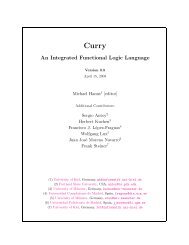Conformal Geometric Algebra in Stochastic Optimization Problems ...
Conformal Geometric Algebra in Stochastic Optimization Problems ...
Conformal Geometric Algebra in Stochastic Optimization Problems ...
Create successful ePaper yourself
Turn your PDF publications into a flip-book with our unique Google optimized e-Paper software.
232 CHAPTER 9. CONCLUSION<br />
• The method of least squares adjustment and the whole frame of parameter<br />
estimation is illustrated. This <strong>in</strong>cludes a survey of the different types of observations<br />
and their correspond<strong>in</strong>g adjustment problems. The focus is on the<br />
l<strong>in</strong>ear Gauss-Helmert model, which can account for all types of observations<br />
simultaneously. The estimation method, i.e. the GH-method, that arises from<br />
the model is hence the most general case of least squares adjustment. In the<br />
end, the GH-method for block observations as used throughout this work is<br />
derived.<br />
• The matrix representation and the crucial tensor representation of GA is<br />
expla<strong>in</strong>ed. On this basis, standard error propagation is adapted to CGA,<br />
that is given a product of two uncerta<strong>in</strong> multivectors the mean and covariance<br />
of the resultant multivector is derived. Error propagation is also applied to<br />
the conformal embedd<strong>in</strong>g as it ultimately represents a function of uncerta<strong>in</strong><br />
arguments.<br />
• Three standard problems are chosen to demonstrate the effectiveness of comb<strong>in</strong><strong>in</strong>g<br />
CGA with the GH-method: first, the estimation of the best circle<br />
pass<strong>in</strong>g through a set of uncerta<strong>in</strong> po<strong>in</strong>ts <strong>in</strong> 3D. Second, fitt<strong>in</strong>g an RBM to<br />
two 3D-po<strong>in</strong>t sets, one of which consists of observations. Third, the perspective<br />
pose estimation problem based on po<strong>in</strong>t features. Each of these issues<br />
clarifies several important aspects: first, the ease with which such problems<br />
can be modeled if CGA is used. Second, the way the tensor representation<br />
of GA makes algebraic condition and constra<strong>in</strong>t equations available to the<br />
GH-method. Third, how smoothly and with which accuracy error propagation<br />
may be <strong>in</strong>tegrated <strong>in</strong>to the framework of geometric algebra. Fourth, the<br />
availability of a covariance matrix for the determ<strong>in</strong>ed parameters that reflects<br />
how well the estimate approximates the observations.<br />
For each problem, the goodness of the respective GH-solution is experimentally<br />
substantiated.<br />
• Omnidirectional imag<strong>in</strong>g us<strong>in</strong>g a s<strong>in</strong>gle-viewpo<strong>in</strong>t paracatadioptric vision system,<br />
with its strengths and weaknesses, is <strong>in</strong>troduced. A simple method for<br />
calibrat<strong>in</strong>g such a system is proposed. Due to its structure, conformal geometric<br />
algebra offers the ideally match<strong>in</strong>g framework to model omnidirectional<br />
imag<strong>in</strong>g <strong>in</strong> a straightforward manner. This and especially the importance of<br />
the related <strong>in</strong>version operation is brought to the fore. To keep track of uncerta<strong>in</strong>ties<br />
under omnidirectional image formation, error propagation for CGA<br />
expressions is employed. The GH-method is applied to three problems: a pose<br />
estimation based on po<strong>in</strong>t features (a 3D-po<strong>in</strong>t model is fitted to projection<br />
rays), a pose estimation based on l<strong>in</strong>e features (a 3D-l<strong>in</strong>e model is fitted to<br />
projection planes) and an epipole estimation.<br />
For the latter concern, epipolar geometry is entirely modeled with<strong>in</strong> CGA.<br />
As a result, a representation for the essential matrix and the fundamental<br />
matrix, respectively, <strong>in</strong> terms of CGA elements arises. Epipole estimation<br />
is lastly established on the basis of the essential matrix. This provides, as<br />
a byproduct, the motion estimation between the two considered omnidirectional<br />
images. It is further proven that the renowned authors of [50] make
















